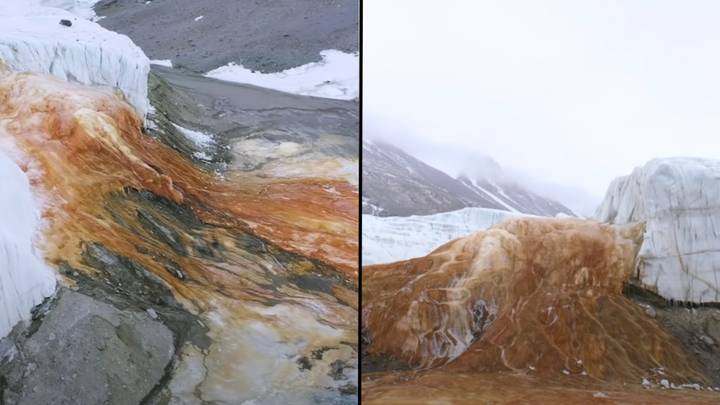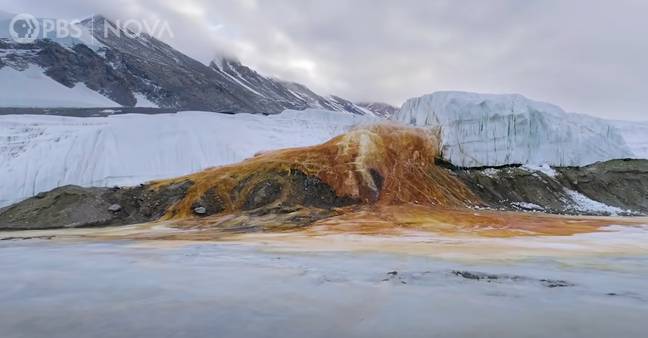
Ready to have your mind blown? Scientists have discovered mysterious ‘pyramid-like’ structures in Antarctica – but they’re not what they seem.
It’s the latest in a series of intriguing discoveries that have turned the things we think we know about our planet on their head.
In recent weeks, palaeontologists discovered that humans were tragically likely responsible for the extinction of world’s only cold-blooded mammal and deep-sea divers made a truly disturbing discovery after finally reaching bottom of the Caribbean’s Great Blue Hole.
And now there’s another strange discovery to be unpacked.
Explorers were left perplexed by a startling phenomena that emerged on satellite images whilst panning over Antarctica.
Photographs of a colossal, pyramid-shaped mass was spotted taken over the southern part of the South Pole’s Ellsworth Mountain range.
Several rather bizarre-looking peaks were spotted in this area, with the largest one measuring a staggering 2km square in each direction at its base.
The structures aren’t too dissimilar in shape and size of the world-famous Pyramids of Giza – which were constructed by Egyptian slaves around 2550 BC.
But, being that the snow-white continent is totally covered in ice and pretty uninhabitable to the average human, scientists are baffled as to how exactly these frozen peaks came into being.

So, given that human beings aren’t famed for their ability to reside in the Antarctic for very long – due to the freezing temperatures down there – it’s no surprise that followers of this remarkable tale of discovery are dying to know how these structures came to be.
And – as in many cases of unexplained marvels – the fan theories surrounding the pyramid’s existence are getting weirder and weirder by the day.
Taking to Twitter, one spectator predicted: “That’s the aliens? I knew it!”
Another suggested: “Illuminati confirmed.”
“Wait, how’d they move the pyramids from Egypt to Antarctica?” a third wondered.
A fourth simply stated: “Humans built that.”
It turns out, however, that these explanation for the existence of these snow-covered shapes is much simpler.

That’s because these pyramids, aren’t pyramids after all.
In fact, Irvine geology professor Eric Rignot has shut down rumours of aliens and Illuminati altogether, having since revealed that these structures are just regular, old mountains.
“Pyramid shapes are not impossible — many peaks partially look like pyramids, but they only have one to two faces like that, rarely four,” he explained.
Rignot – professor of Earth system science at the University of California – went on to explain that the huge points emerging from the land are known as ‘pyramidal peaked mountains’, and are formed from the convergence of glaciers on the sides of an existing landmass.
And apparently, these types of mountain aren’t exactly uncommon, being that Iceland’s Mount Búlandstindur in Iceland, and Bordoyarnes Mountain on the Faroe Islands share the exact same components.
Elon Musk announces first Neuralink brain chip has been implanted in a human with very specific goal
Published
| Last updated

Featured Image Credit: Antonio Masiello/Getty Images/Neuralink
Elon Musk has announced that the first Neuralink brain chip has been implanted into a human.
The tech tycoon’s latest business venture looks like it could blow Tesla and SpaceX out of the water if its successful.
He founded the neurotechnology company – alongside a team of seven scientists and engineers – which has been hailed as the future for humanity, and a lifeline for people with severe impairments.
Musk has got a list as long as his arm about all the things his brain chips could do – but there is a very specific goal that he is working towards at the forefront of his mind.
In a series of posts on his social media platform X, he explained that human trials for Neuralink, referred to as the PRIME Study, were now underway and that the first patient has had the ‘invisible brain-computer’ implanted.
The pioneering company previously explained that a robot which they have developed would surgically place the implants ‘ultra fine’ threads – which help transmit signals in the patient’s brain – throughout the landmark study.
In a post on Monday (29 January), Musk said: “The first human received an implant from Neuralink yesterday and is recovering well. Initial results show promising neuron spike detection.”
 Musk said the patient was ‘recovering well’. Credit: Antonio Masiello/Getty Images
Musk said the patient was ‘recovering well’. Credit: Antonio Masiello/Getty Images
Spikes are the activity by neurons – which are cells that use electrical and chemical signals to send information around the brain and to the body, according to the National Institute of Health.
Musk revealed that the name of the first product which is currently being trialled is ‘Telepathy, explaining that it ‘enables control of your phone or computer, and through them almost any device, just by thinking’.
He added: “Initial users will be those who have lost the use of their limbs. Imagine if Stephen Hawking could communicate faster than a speed typist or auctioneer. That is the goal.”
Musk reckons people with obesity, autism, depression, and schizophrenia, as well as quadriplegics could be the biggest beneficiaries of the device.
The US Food and Drug Administration (FDA) gave Neuralink the ability to carry out human trials back in September last year after an independent review board gave the company the green light.

In a statement celebrating the approval, Neuralink said the study would be ‘groundbreaking’ and outlined what the company would be looking at intently.
The firm are evaluating the safety of the implant as well as the surgical robot which carries out the procedure, and the functionality of the brain chip for ‘enabling people with paralysis to control external devices with their thoughts’.
Neuralink said: “Micron-scale threads would be inserted into areas of the brain that control movement. Each thread contains many electrodes and connects them to an implant called the ‘Link’.
“The threads on the Link are so fine and flexible that they can’t be inserted by the human hand.
“Instead, we are building a robotic system that is designed to reliably and efficiently insert these threads exactly where the neurosurgeon wants them to be.”
Scientists found a hidden corridor in the Great Pyramid of Giza

Featured Image Credit: Egyptian Ministry of Antiquities / PA
Scientists recently discovered a hidden corridor in the Great Pyramid of Giza, potentially paving the way for them to find more interesting stuff from millennia ago.
The Pyramids in Egypt continue to fascinate people thousands of years after they were built, from archaeologists to conspiracy theorists.
There are all sorts of ideas about them, from alien civilisations to ancient curses, but a lot of the time the truth – or things we actually know about them – can be as interesting as the fiction.
On this occasion – specifically in March 2023 – the scientists discovered a nine-metre hidden passageway within the Pyramid of Khufu, built for the ancient ruler of the same name.

The discovery was announced by the Egyptian tourism and antiquities minister on 2 March, and he was clearly excited about the opportunities that it might bring, not only for further exploration, but also tourism to his country.
As is so often the case with discoveries such as this one, we can’t actually tell you that much about the corridor yet, as we’re not 100 percent sure what it was for.
That only means that there’s more to learn though, which will be exciting news for the scientists and archaeologists who are tasked with finding out.
Obviously, there will be those who will warn about ancient curses in hidden passageways such as this, but that will presumably not deter them in their quest.
The discovery was made by a group called Scan Pyramid.
Have a quick guess what they do.
Since 2015, they’ve been using state-of-the-art technology to see the inside of the pyramid from the outside.
That has involved the use of infrared thermography, scanning to make a clearer picture of what actually lurks within Khufu’s supposed tomb.

According to Mostafa Waziri, the head of the Egyptian Supreme Council of Antiquities, the ceiling of this newly discovered passageway was built to relieve the weight of the rest of the pyramid, which is the largest in Egypt and currently stands at over 138 metres tall.
It was once 146 metres plus, but times have changed since then.
Elaborating, Waziri said: “A big question mark hangs over whether this corridor was created to relieve the weight on the [main] entrance or lighten the load on a space yet to be discovered.”
“Scanning work will continue to uncover more secrets,” he added.
Keep going folks – if there’s more secrets to learn about the pyramids, you can guarantee there will be people interested to learn about them.
Watch out for evil mummies and curses, though.
Mystery of ‘bleeding’ waterfalls in Antarctica finally solved after decades
Published
| Last updated

Featured Image Credit: YouTube/GeologyHub
The mystery of the ‘bleeding’ waterfalls in Antarctica were solved after decades of confusion and speculation.
Take a look at any picture or video of Blood Falls and you’ll soon see where it gets its name.
Ever since it was discovered in 1911 by Australian geologist Thomas Griffith Taylor, people have tried to figure out why the phenomenon looks the way it does.
For decades, numerous hypotheses were put forward, ranging from the regular, such as red algae, to the ridiculous, i.e. alien portals.
As said by Arlo Pérez, co-host of PBS Terra’s Antarctic Extremes series: “It looks more like Mars than Earth.”
Meanwhile, fellow co-host Caitlin Saks jokes: “Honestly? I think of the glacier having its period.”
Although it might look like the time of the month has arrived for this corner of the world, there’s a far more reasonable explanation.

As well as its red hues, scientists wanted to figure out why Blood Falls consists of flowing water, considering it does so in a place where the mean temperature is nearly -19 degrees Celcius and there’s minimal melting at the surface.
Thanks to a study by researchers at the University of Alaska Fairbanks, including National Geographic explorer Erin C Pettit, we now know the answers to these questions.
Using radio-echo sounding, which allowed the team to map out the features of the area, they discovered the water is extremely salty – we’re talking more than twice as much salt content as sea water.
They also found that the brine is high in iron, and since it is initially cut off from the atmosphere, when it comes into contact with oxygen, it oxidises – or rusts. Hence the unusual colouring.
As for why the water flows rather than freezes, it’s because saltwater has a higher freezing point.
Pettit explains: “While it sounds counterintuitive, water releases heat as it freezes, and that heat warms the surrounding colder ice.

“This source of heat within Taylor Glacier combines with the lower freezing temperature of salty water (brine) to make brine movement in the extremely cold ice possible.
“Taylor Glacier is now the coldest known glacier to have persistently flowing water.”
Now, you might be wondering why the water here is so rich in salt and iron, and to answer this we have to go back around five million years.
Back then, it’s believed that the Dry Valleys were actually beneath the ocean, and when the climate changed and the sea level dropped, the salty water was left isolated as a lake.
The team’s hypothesis goes on to suggest that approximately 1.5 million years ago, a glacier advanced over the lake, leading to the salty brine that feeds Blood Falls today.
Researchers solve the mystery behind ‘bleeding’ Antarctica waterfall
Published
| Last updated

Featured Image Credit: YouTube/PBS Terra
The mystery of a red-hued glacier outlet – dubbed Blood Falls – has been solved decades after it was first spotted.
The eerie-looking phenomenon was first noted all the way back in 1911 after the crew of a British expedition to Antarctica noticed that one glacier appeared to be ‘bleeding’ onto a frozen lake.
Due to its colour, the spot on Taylor Glacier was given the name Blood Falls and its true cause remained a mystery for decades.
US scientists visited the spot in 2006 and again in 2018 where they collected samples which were then analysed using new technology and equipment.
Despite numerous studies taking place on Blood Falls’ chemistry and microbes living in the water – a full mineralogical make-up had not been undertaken, until last year.
Using new scientific equipment, researchers were finally able to uncover the secrets of Blood Falls.

Materials scientist Ken Livi from Johns Hopkins University, who worked on the study, explained: “As soon as I looked at the microscope images, I noticed that there were these little nanospheres and they were iron-rich.”
The teeny particles, which are a hundredth of the size of human red blood cells, were found to have come from ancient microbes and were found to be abundant in the meltwaters of Taylor Glacier.
The tiny particles – or nanospheres – contain silicon, calcium, aluminium, and sodium, as well as iron, and this specific make up is what is partly responsible for turning the water red as it slips off the glacier and finds sunlight, oxygen and warmth for the first time in a very long time.
Livi explained: “In order to be a mineral, atoms must be arranged in a very specific, crystalline, structure.
“These nanospheres aren’t crystalline, so the methods previously used to examine the solids did not detect them.”

The glacier is home to an ancient microbial community hundreds of meters under its ice, which has evolved over centuries – meaning it can provide useful insights for astrobiologists, hoping to discover hidden life forms on other planets.
The study also suggested that even if there is life on other planets – such as Mars – humans won’t be able to detect it unless they have the correct equipment.
Livi said: “Our work has revealed that the analysis conducted by rover vehicles is incomplete in determining the true nature of environmental materials on planet surfaces.
“This is especially true for colder planets like Mars, where the materials formed may be nanosized and non-crystalline. Consequently, our methods for identifying these materials are inadequate.”



![Cops Seize Enough Liquid Heroin To Kill 53 Million People In One Cartel Bust [VIDEO]](https://shtf.tv/wp-content/uploads/2024/02/Cops-Seize-Enough-Liquid-Heroin-To-Kill-53-Million-People-In-One-Cartel-Bust-VIDEO-150x150.jpg)